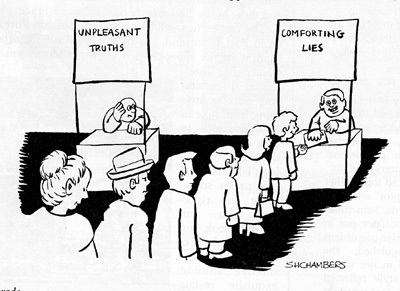
I found myself reading an old (1944) paper by Erich Fromm while I was digging into one of his books, The Sane Society, I have just discovered. Having read a lot of Fromm, who is one of my prime sources of inspiration, I was delighted to find yet another equally meaningful work. I won’t comment on the book’s main theme here, but will say that his questioning the sanity of societies like ours is as valid in 2017 as it was in 1955 when the book was published.
The following excerpt comes from an earlier paper of his that Fromm used for this book. The paper, “Individual and Social Origins of Neurosis,” starts with a discussion of scientific truths, which I find very relevant almost 75 years after the paper was published.*
The history of science is a history of erroneous statements. Yet these erroneous statements which mark the progress of thought have a particular quality: they are productive. And they are not just errors either; they are statements, the truth of which is veiled by misconceptions, is clothed in erroneous and inadequate concepts. They are rational visions which contain the seed of truth, which matures and blossoms in the continuous effort of mankind to arrive at objectively valid knowledge about man and nature. Many profound insights about man and society have first found expression in myths and fairy tales, others in metaphysical speculations, others in scientific assumptions which have proven to be incorrect after one or two generations.
It is not difficult to see why the evolution of human thought proceeds in this way. The aim of any thinking human being is to arrive at the whole truth,to understand the totality of phenomena which puzzle him. He has only one short life and must want to have a vision of the truth about the world in this short span of time. But he could only understand this totality if his life span were identical with that of the human race. It is only in the process of historical evolution that man develops techniques of observation, gains greater objectivity as an observer, collects new data which are necessary to know if one is to understand the whole. There is a gap, then, between what even the greatest genius can visualize as the truth, and the limitations of knowledge which depend on the accident of the historical phase he happens to live in. Since we cannot live in suspense, we try to fill out this gap with the material of knowledge at hand, even if this material is lacking in the validity which the essence of the vision may have.
Every discovery which has been made and will be made has a long history in which the truth contained in it finds a less and less veiled and distorted expression and approaches more and more adequate formulations. The development of scientific thought is not one in which old statements are discarded as false and replaced by new and correct ones; it is rather a process of continuous reinterpretation of older statements, by which their true kernel is freed from distorting elements. The great pioneers of thought, of whom Freud is one, express ideas which determine the progress of scientific thinking for centuries. Often the workers in the field orient themselves in one of two ways: they fail to differentiate between the essential and the accidental, and defend rigidly the whole system of the master, thus blocking the process of reinterpretation and clarification; or they make the same mistake of failing to differentiate between the essential and the accidental, and equally rigidly fight against the old theories and try to replace them by new ones of their own, In both the orthodox and the rebellious rigidity, the constructive evolution of the vision of the master is blocked. The real task, however, is to reinterpret, to sift out, to recognize that certain insights had to be phrased and understood in erroneous concepts because of the limitations of thought peculiar to the historical phase in which they were first formulated. We may feel then that we sometimes understand the author better than he understood himself, but that we are only capable of doing so by the guiding light of his original vision (my emphasis added).
A couple of comments on why I find this interesting. The second paragraph is an argument that part of the essence of being human, as opposed to just any old animal, is “to understand to understand the totality of phenomena which puzzle him.” In the book, he expands on this, arguing that the key feature that separates humans from all the other animal species is our existential longing, the drive to live in a meaningful manner. When we live in a way that is incoherent with that, as he argues we do in the insane modern world, we, as individuals fail to attain the potential of our humanness. We do not and cannot flourish in the language I use. Deliberate lying about the world only pushes us further away.
The second comes in the last paragraph in the part I have bolded. I read this as saying that scientific facts are historically situated and reflect “reinterpretations” that have been made over time. If some facts have persisted without such reinterpretations, they may no longer truthfully represent the world. This thought is central to my critique of modernity and lies at the base of my argument that two basic “scientific” models about the nature of the world and its human beings need such reinterpretation in the light of what we now know about both of them some four centuries after these ‘truths” were uttered. The modern scientific establishment continues to defend the masters of these beliefs, Rene Descartes and Adam Smith, and so continues to block progress toward truths that are critical in acting in today’s world.
* American Sociological Review (1944) 9 (4), pp. 380-384